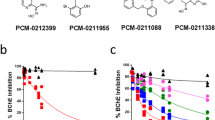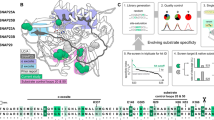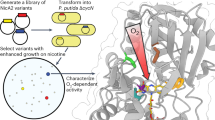Abstract
Organophosphate nerve agents are extremely lethal compounds. Rapid in vivo organophosphate clearance requires bioscavenging enzymes with catalytic efficiencies of >107 (M−1 min−1). Although serum paraoxonase (PON1) is a leading candidate for such a treatment, it hydrolyzes the toxic Sp isomers of G-agents with very slow rates. We improved PON1's catalytic efficiency by combining random and targeted mutagenesis with high-throughput screening using fluorogenic analogs in emulsion compartments. We thereby enhanced PON1's activity toward the coumarin analog of Sp-cyclosarin by ∼105-fold. We also developed a direct screen for protection of acetylcholinesterase from inactivation by nerve agents and used it to isolate variants that degrade the toxic isomer of the coumarin analog and cyclosarin itself with kcat/KM ∼ 107 M−1 min−1. We then demonstrated the in vivo prophylactic activity of an evolved variant. These evolved variants and the newly developed screens provide the basis for engineering PON1 for prophylaxis against other G-type agents.
This is a preview of subscription content, access via your institution
Access options
Subscribe to this journal
Receive 12 print issues and online access
$259.00 per year
only $21.58 per issue
Buy this article
- Purchase on Springer Link
- Instant access to full article PDF
Prices may be subject to local taxes which are calculated during checkout

Similar content being viewed by others
References
Doctor, B.P. & Saxena, A. Bioscavengers for the protection of humans against organophosphate toxicity. Chem. Biol. Interact. 157–158, 167–171 (2005).
Lenz, D.E. et al. Stoichiometric and catalytic scavengers as protection against nerve agent toxicity: a mini review. Toxicology 233, 31–39 (2007).
Ashani, Y. & Pistinner, S. Estimation of the upper limit of human butyrylcholinesterase dose required for protection against organophosphates toxicity: a mathematically based toxicokinetic model. Toxicol. Sci. 77, 358–367 (2004).
diTargiani, R.C., Chandrasekaran, L., Belinskaya, T. & Saxena, A. In search of a catalytic bioscavenger for the prophylaxis of nerve agent toxicity. Chem. Biol. Interact. 187, 349–354 (2010).
Ghanem, E. & Raushel, F.M. Detoxification of organophosphate nerve agents by bacterial phosphotriesterase. Toxicol. Appl. Pharmacol. 207, 459–470 (2005).
Mee-Hie Cho, C., Mulchandani, A. & Chen, W. Functional analysis of organophosphorus hydrolase variants with high degradation activity towards organophosphate pesticides. Protein Eng. Des. Sel. 19, 99–105 (2006).
Melzer, M. et al. Reversed enantioselectivity of diisopropyl fluorophosphatase against organophosphorus nerve agents by rational design. J. Am. Chem. Soc. 131, 17226–17232 (2009).
Tsai, P.C. et al. Stereoselective hydrolysis of organophosphate nerve agents by the bacterial phosphotriesterase. Biochemistry 49, 7978–7987 (2010).
Ashani, Y., Rothschild, N., Segall, Y., Levanon, D. & Raveh, L. Prophylaxis against organophosphate poisoning by an enzyme hydrolysing organophosphorus compounds in mice. Life Sci. 49, 367–374 (1991).
Broomfield, C.A. A purified recombinant organophosphorus acid anhydrase protects mice against soman. Chem. Biol. Interact. 87, 279–284 (1993).
Li, W.F., Furlong, C.E. & Costa, L.G. Paraoxonase protects against chlorpyrifos toxicity in mice. Toxicol. Lett. 76, 219–226 (1995).
Kassa, J., Karasova, J.Z., Caisberger, F. & Bajgar, J. The influence of combinations of oximes on the reactivating and therapeutic efficacy of antidotal treatment of soman poisoning in rats and mice. Toxicol. Mech. Methods 19, 547–551 (2009).
Harvey, S.P. et al. Stereospecificity in the enzymatic hydrolysis of cyclosarin (GF). Enzyme Microb. Technol. 37, 547–555 (2005).
Li, W.S., Lum, K.T., Chen-Goodspeed, M., Sogorb, M.A. & Raushel, F.M. Stereoselective detoxification of chiral sarin and soman analogues by phosphotriesterase. Bioorg. Med. Chem. 9, 2083–2091 (2001).
Amitai, G. et al. Enhanced stereoselective hydrolysis of toxic organophosphates by directly evolved variants of mammalian serum paraoxonase. FEBS J. 273, 1906–1919 (2006).
Aharoni, A. et al. Directed evolution of mammalian paraoxonases PON1 and PON3 for bacterial expression and catalytic specialization. Proc. Natl. Acad. Sci. USA 101, 482–487 (2004).
Gaidukov, L. et al. In vivo administration of BL-3050: highly stable engineered PON1-HDL complexes. BMC Clin. Pharmacol. 9, 18 (2009).
Ashani, Y. et al. Stereo-specific synthesis of analogs of nerve agents and their utilization for selection and characterization of paraoxonase (PON1) catalytic scavengers. Chem. Biol. Interact. 187, 362–369 (2010).
Gupta, R.D. & Tawfik, D.S. Directed enzyme evolution via small and effective neutral drift libraries. Nat. Methods 5, 939–942 (2008).
Aharoni, A., Amitai, G., Bernath, K., Magdassi, S. & Tawfik, D.S. High-throughput screening of enzyme libraries: thiolactonases evolved by fluorescence-activated sorting of single cells in emulsion compartments. Chem. Biol. 12, 1281–1289 (2005).
Mastrobattista, E. et al. High-throughput screening of enzyme libraries: in vitro evolution of a beta-galactosidase by fluorescence-activated sorting of double emulsions. Chem. Biol. 12, 1291–1300 (2005).
Herman, A. & Tawfik, D.S. Incorporating Synthetic Oligonucleotides via Gene Reassembly (ISOR): a versatile tool for generating targeted libraries. Protein Eng. Des. Sel. 20, 219–226 (2007).
Romano, J.A., Lukey, B.J. & Salem, H. Chemical warfare agents: chemistry, pharmacology, toxicology, and therapeutics. (CRC Press, Boca Raton, 2008).
Amitai, G. et al. Asymmetric fluorogenic organophosphates for the development of active organophosphate hydrolases with reversed stereoselectivity. Toxicology 233, 187–198 (2007).
Luo, C., Chambers, C., Yang, Y. & Saxena, A. Mechanism for potent reactivation ability of H oximes analyzed by reactivation kinetic studies with cholinesterases from different species. Chem. Biol. Interact. 187, 185–190 (2010).
Reetz, M.T., Kahakeaw, D. & Lohmer, R. Addressing the numbers problem in directed evolution. ChemBioChem 9, 1797–1804 (2008).
Fox, R.J. et al. Improving catalytic function by ProSAR-driven enzyme evolution. Nat. Biotechnol. 25, 338–344 (2007).
Shapiro, M.G. et al. Directed evolution of a magnetic resonance imaging contrast agent for noninvasive imaging of dopamine. Nat. Biotechnol. 28, 264–270 (2010).
Acknowledgements
Financial support by US National Institutes of Health (W81XWH-07-2-0020) and the Defense Threat Reduction Agency (HDTRA 1-07-C-0024) is gratefully acknowledged. We thank D. Tal and the Israel Structural Proteomics Centre for assistance with protein production and T. Magliery, D. Lenz and D. Cerasoli for a fruitful collaboration.
Author information
Authors and Affiliations
Contributions
R.D.G. constructed and screened variant libraries by FACS and plate screening with coumarin substrates, characterized evolved variants, analyzed data and wrote the paper. M.G. constructed and screened variant libraries using coumarin and in situ–generated substrates, characterized selected variants, performed in vivo experiments, analyzed data and wrote the paper. Y.A. designed and synthesized coumarin and fluoride substrates, established the AChE assay, characterized selected variants, designed and performed in vivo experiments and contributed to writing and editing the paper. Y.S. screened variant libraries. G.M. constructed and screened the first-generation variant libraries. H.B. generated recombinant AChE. M.B.-D. assisted the design of targeted libraries. H.L. synthesized the coumarin and fluoride substrates. R.M. performed in vivo experiments. I.S. contributed to writing and editing the paper. J.L.S. performed structural analysis and contributed to writing the paper. D.S.T. designed the experiments, analyzed data and wrote the paper.
Corresponding author
Ethics declarations
Competing interests
The authors declare no competing financial interests.
Supplementary information
Supplementary Text and Figures
Supplementary Methods and Supplementary Results (PDF 357 kb)
Rights and permissions
About this article
Cite this article
Gupta, R., Goldsmith, M., Ashani, Y. et al. Directed evolution of hydrolases for prevention of G-type nerve agent intoxication. Nat Chem Biol 7, 120–125 (2011). https://doi.org/10.1038/nchembio.510
Received:
Accepted:
Published:
Issue Date:
DOI: https://doi.org/10.1038/nchembio.510
This article is cited by
-
Insights into the role of paraoxonase 2 in human pathophysiology
Journal of Biosciences (2022)
-
Targeting organophosphorus compounds poisoning by novel quinuclidine-3 oximes: development of butyrylcholinesterase-based bioscavengers
Archives of Toxicology (2020)
-
Cytoplasmic glycoengineering enables biosynthesis of nanoscale glycoprotein assemblies
Nature Communications (2019)
-
Innovative Biocatalysts as Tools to Detect and Inactivate Nerve Agents
Scientific Reports (2018)
-
Discovery of human-like L-asparaginases with potential clinical use by directed evolution
Scientific Reports (2017)



